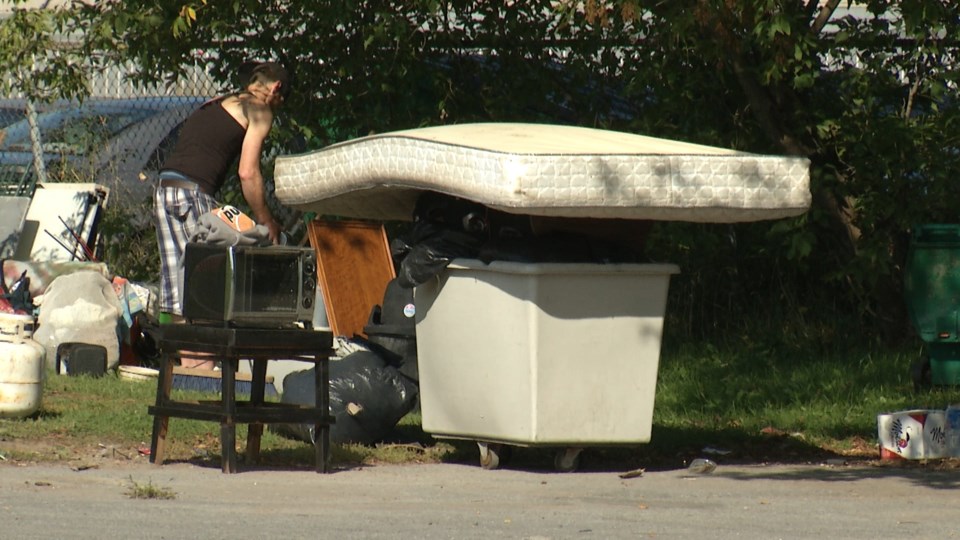Sun blistered and haggard, Manual sits at his usual spot on the curb outside of a Longmont King Soopers parking lot. His self-made cardboard sign “Anything Green Helps” greets motorists making a run for groceries they will likely share later in their homes at dinner time.
Manual says he’s been homeless on-and-off for several years and sums up his life with a shrug and a matter-of-fact: “It is what it is.”
Manual (or Manuel. “It doesn’t really matter,” he says) nods when members of a homeless outreach team that has circulated in Longmont since April hands him a cool bottle of water and a small orange. He also gets a paper sack packed with nutritious protein snacks.
The three-person Longmont Targeted Engagement and Referral Effort, or LThere, team will also supply Manual with anything else he may need, from cleaning wipes to socks or underwear. The LThere team consists of Leah Hobart, street coordinator and peer advocate; Max Stebelton, mental health outreach worker; and Wes Wickland, street outreach specialist.
They travel in an SUV packed with food, clothing and necessaries to spots in Longmont where the homeless usually gather. The team carries cards and other information about agencies that will help people get off the streets and into stable housing. Those include Homeless Outreach Providing Encouragement and Recovery Cafe Longmont, said Hobart.
Hobart ‒ who was homeless in Longmont for two years ‒ said the team also asks questions about each person’s health and welfare, keeping them updated on COVID-19 screening and prevention.
The queries come without judgement and are aimed to supply a simple cup of human kindness to people scrambling to survive, Hobart said.
“We just want to let them know that somebody does care about them,” Hobart said. “It’s so easy to be in this situation and believe people have simply given up on them. Everything at this point is just trying to get some food and some shelter. We try to offer some compassion and empathy.”
The LThere team works five days a week and sees about 20 people a day. Many are regulars always mixed in with new faces, she said.
Most are forced onto the streets by a job loss or bills and living costs they can no longer manage. “So many people are just one paycheck away from living out of their car or on the street,” Hobart said. Many more are “couch surfing,” or living temporarily with a friend or family member.
A common belief is that all homeless are alcoholics or drug addicts, Hobart said, noting most people who land on the streets are not substance abusers. “But the trauma of being homeless, always worrying about survival, leads many to search for an escape through alcohol or drugs,'' said Hobart, who while homeless, was beaten severely one day while looking for shelter.
“Being homeless, she added, “means there is always something lurking around the corner.”
The Longmont team is part of Tgthr, a Boulder-based non-profit that has done outreach efforts to help homeless adults and youth in the Boulder area, said Tgthr’s Outreach Manager Garrett Schilling.
Tgthr emphasizes daily on-the-ground outreach to people on the streets to get them the help they may need, Schilling said, a philosophy that led Longmont officials to contact Tgthr to help in its homeless efforts.
“We are one of the few agencies that I know of that takes that kind of approach,” Schilling said. “We want to build rapport with people, get to know them and help them in whatever we can. Help them reach whatever goals they may have,” Schilling said.
The Longmont team is grant-funded through the end of 2021, said Longmont’s Community Services Director Karen Roney.
As far as the number of homeless in Longmont, Roney said the team has contacted 151 “unduplicated people'' to date in 2021. That is a period from March 2021 through the end of June 2021, Roney said via email.
“We do our best to use the data we have regarding the number of people who are experiencing homelessness in our communities,” Roney said. “As an example, the 2019 point in time count (the official HUD count) for all of Boulder County was in the high 600s.”
Hobart said she was able to get off the streets and beat her alcohol addiction, thanks to Longmont’s LEAD (Law Enforcement Assisted Diversion) program. It calls for police to identify low-level offenders with substance abuse or behavioral health problems and get them to a recovery program.
Hobart said she tries to use her experiences to assure the homeless there are other avenues they can follow. “There is always hope,” she said.



